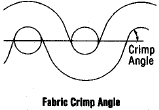KERATIN: The basic protein constituent of wool and other hair fibers.
KERSEY: A heavily fulled or milled woolen fabric having a high lustrous nap and a “grainy” face, kersey is frequently used in overcoats.
KHAKI:
- A light yellowish brown.
- A khaki-colored cloth of cotton, wool, or combinations of these fibers with manufactured fibers used primarily in military uniforms and workclothes.

KIER: A large metal tank, capable of being heated uniformly, used for wet processing.
KIER BOILING: Process of boiling cellulosic materials in alkaline liquors in a kier at or above atmospheric pressure.
KINK:
- In fabrics, a place where a short length of yarn has spontaneously doubled back on itself.
- In yarn, see SNARL.
KINKY THREAD: See KINK.


